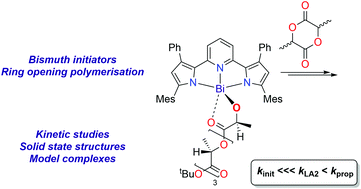Sterically rigid bismuth pincer complexes; observation of the growing polymer chain in polar monomer polymerisation†
Abstract
A family of pyridine dipyrrolide bismuth complexes (Mes,PhL)MX (1–6) (M = Bi, X = O-2,6-Me-C6H3 = OXyl (1); M = Sb, X = OXyl (2); M = Bi, X = O-2,6-iPr-C6H3 = ODipp (3), O-2,6-tBu-C6H3 = OArtBu (4), OtBu (5) and OCMe2Et = OAm (6), N(SiMe3)2 = N′′ (7) and CH2Ph (8)) have been prepared and investigated as initiators for the ring-opening polymerisation of lactide monomers. Bismuth lactate complexes (Mes,PhL)Bi{OC(H)(Me)C(![[double bond, length as m-dash]](https://www.rsc.org/images/entities/char_e001.gif) O)OR} were prepared as models for the propagating species (R = tBu (9), Me (10), iPr (11)). The first insertion of the lactide monomer is rate limiting and the second and subsequent insertions are more rapid (kinit ≪ kLA2 < kprop), leading to a significant induction period. The sterically demanding, rigid pincer ligand affords a well-defined coordination environment at the metal centre and allows for the enchainment of two lactide monomers to be differentiated spectroscopically ((Mes,PhL)Bi{OC(H)(Me)C(
O)OR} were prepared as models for the propagating species (R = tBu (9), Me (10), iPr (11)). The first insertion of the lactide monomer is rate limiting and the second and subsequent insertions are more rapid (kinit ≪ kLA2 < kprop), leading to a significant induction period. The sterically demanding, rigid pincer ligand affords a well-defined coordination environment at the metal centre and allows for the enchainment of two lactide monomers to be differentiated spectroscopically ((Mes,PhL)Bi{OC(H)(Me)C(![[double bond, length as m-dash]](https://www.rsc.org/images/entities/char_e001.gif) O)}4OX (12-X)), with this species also implied to be the true initiator for the regime of propagation with first order kinetics. Well-controlled first order kinetic data for the polymerisation of L-, D-, rac- and meso-lactide are observed.
O)}4OX (12-X)), with this species also implied to be the true initiator for the regime of propagation with first order kinetics. Well-controlled first order kinetic data for the polymerisation of L-, D-, rac- and meso-lactide are observed.



 Please wait while we load your content...
Please wait while we load your content...